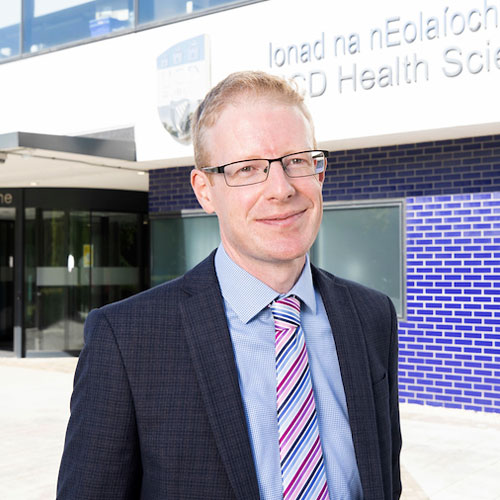
Member Spotlight for October 2022:
Jonathan McNulty

Jonathan McNulty, Ph.D., H.Dip.(R)
Associate Dean / Associate Professor
School of Medicine, University College Dublin
Dublin, Ireland
ISMRT Member since 2019
While I was a student on the B.Sc. (Hons) Radiography programme at University College Dublin, there were many subjects I took across the four years, but MRI was one of the subjects that really captured me, both because of the theory and also from spending time working in MRI while on clinical placement. Upon graduation, I began working clinical at Beaumont Hospital in Dublin, a large university teaching hospital which was also the national neurosurgical centre. I had the opportunity to work alongside a very large team of radiographers, radiologists, and a multitude of other professionals, and soon had the chance to train in both interventional radiology and in MRI. Both areas of the radiology department were really exciting to work in at the time, but equally, both were also extremely busy, high-pressure, high-stress environments at times. This led to a further opportunity to pursue a postgraduate diploma in MRI. One of the things I enjoyed most was training new team members and students who rotated through these areas. This was particularly rewarding in MRI, where aspects of the MR physics and optimisation strategies could often prove challenging to teach and understand. Then in 2003, I had the opportunity to begin a joint appointment between the hospital and University College Dublin, where for two years I spent some of my time working clinically: some of my time as a clinical placement tutor for radiography students, and some of my time as a lecturer and researcher. In 2015, I then switched to a full time academic role at the university.
While it is great to be in a position where I can lead research studies exploring novel clinical applications of MRI, I am equally enthusiastic, and possibly over-enthusiastic, about covering the basic principles of MRI to first-year radiography and medicine students. It is a privilege to be in a position where you are responsible for breaking down what can be complex topics and finding new ways of providing clarity and understanding to the next generation of professionals: the radiographers who will be performing the examinations and hopefully equally enthusiastic about optimisation, and the doctors who will be justifying and referring their patients for MRI (and some of who will go on to specialise in radiology).
A typical day for me involves an early start, in an effort to avoid the chaos that can be traffic in and around Dublin, and arrive in the office by 07:30 a.m. My days at UCD vary considerably, and this is part of the excitement and also the challenge of being an academic. Days can be a non-stop mix of meetings, classes, administration, and too many emails, interspersed with coffee and chats with some great colleagues. I am now in a senior leadership role within my own school, the School of Medicine, where I am an associate dean with responsibility for all postgraduate programmes and CPD across the School. Separately, I am the Vice Principal for Teaching and Learning of the wider College of Health and Agricultural Sciences, which comprises my School, the Schools of Agriculture and Food Science; Nursing, Midwifery and Health Systems; Public Health, Physiotherapy and Sports Sciences; and Veterinary Medicine (over 7,500 students in total). I am also in an active research with ongoing projects linked to MR optimisation, advanced MR applications (in both stroke and knee imaging), dose-image optimisation in ionising radiation examinations, the patient experience, and, of course, research linked to teaching, learning, and assessment. I am currently supervising four Ph.D. students, three of whom are undertaking research linked to MRI.
At the end of a working day, it is time to again face the traffic and get home to eat with the family, check homework, and to bring our children to their swimming and Gaelic training sessions (where, as a coach, the work continues).
What I love most about ISMRT is a mix of high-quality science and high-quality education that are at the heart of the ISMRM/ISMRT. What more could you want? One of the strengths I see within the ISMRM/ISMRT is the committee structures, along with the Study Groups and Chapters. There really are so many opportunities for members to get actively involved in the organisation. Personally, I do hope to contribute more to the ISMRM/ISMRT in the future; however, I am already probably over-committed through roles outside the University with international organisations. I am currently a member of the MR Safety, Cardiac MR, and Musculoskeletal MR Study Groups. I am the current Editor-in-Chief of Radiography, the international journal of diagnostic imaging and radiation therapy and the top-ranked journal linked to my profession. Radiography is the official journal of the EFRS, and I would welcome all members of the MR community to consider Radiography as a destination for their work on MR optimisation, MR safety, patient-centred MRI, and indeed any topics of interest to MR readers.
I am married to a former radiography classmate who is an MRI clinical specialist / lead in a private hospital in Dublin, which has the busiest MR service in the country. We have two children, both in primary school, who are the centre of our lives. I spend my spare time coaching underage Gaelic football and hurling, our national sports, where I have been involved with my son’s team for some time. I attempt to get out and run when possible and, as a family, we all love going for long walks. I also have a love of books and reading. Through the pandemic, I have developed a new found enthusiasm for gardening; although my knowledge and skills in this area remain poor!
